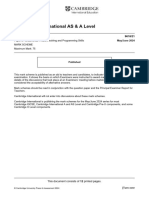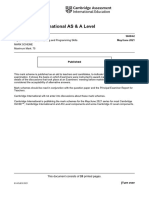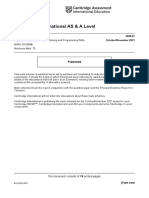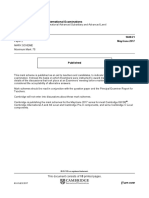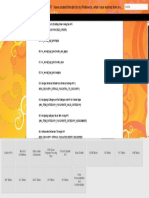Cambridge Assessment International Education: Computer Science 9608/23 May/June 2018
Cambridge Assessment International Education: Computer Science 9608/23 May/June 2018
Uploaded by
gerald.mwangiCopyright:
Available Formats
Cambridge Assessment International Education: Computer Science 9608/23 May/June 2018
Cambridge Assessment International Education: Computer Science 9608/23 May/June 2018
Uploaded by
gerald.mwangiOriginal Title
Copyright
Available Formats
Share this document
Did you find this document useful?
Is this content inappropriate?
Copyright:
Available Formats
Cambridge Assessment International Education: Computer Science 9608/23 May/June 2018
Cambridge Assessment International Education: Computer Science 9608/23 May/June 2018
Uploaded by
gerald.mwangiCopyright:
Available Formats
Cambridge Assessment International Education
Cambridge International Advanced Subsidiary and Advanced Level
COMPUTER SCIENCE 9608/23
Paper 2 Written Paper May/June 2018
MARK SCHEME
Maximum Mark: 75
Published
This mark scheme is published as an aid to teachers and candidates, to indicate the requirements of the
examination. It shows the basis on which Examiners were instructed to award marks. It does not indicate the
details of the discussions that took place at an Examiners’ meeting before marking began, which would have
considered the acceptability of alternative answers.
Mark schemes should be read in conjunction with the question paper and the Principal Examiner Report for
Teachers.
Cambridge International will not enter into discussions about these mark schemes.
Cambridge International is publishing the mark schemes for the May/June 2018 series for most
Cambridge IGCSE™, Cambridge International A and AS Level and Cambridge Pre-U components, and
some Cambridge O Level components.
IGCSE™ is a registered trademark.
This document consists of 13 printed pages.
© UCLES 2018 [Turn over
9608/23 Cambridge International AS/A Level – Mark Scheme May/June 2018
PUBLISHED
Generic Marking Principles
These general marking principles must be applied by all examiners when marking candidate answers.
They should be applied alongside the specific content of the mark scheme or generic level descriptors
for a question. Each question paper and mark scheme will also comply with these marking principles.
GENERIC MARKING PRINCIPLE 1:
Marks must be awarded in line with:
• the specific content of the mark scheme or the generic level descriptors for the question
• the specific skills defined in the mark scheme or in the generic level descriptors for the question
• the standard of response required by a candidate as exemplified by the standardisation scripts.
GENERIC MARKING PRINCIPLE 2:
Marks awarded are always whole marks (not half marks, or other fractions).
GENERIC MARKING PRINCIPLE 3:
Marks must be awarded positively:
• marks are awarded for correct/valid answers, as defined in the mark scheme. However, credit
is given for valid answers which go beyond the scope of the syllabus and mark scheme,
referring to your Team Leader as appropriate
• marks are awarded when candidates clearly demonstrate what they know and can do
• marks are not deducted for errors
• marks are not deducted for omissions
• answers should only be judged on the quality of spelling, punctuation and grammar when these
features are specifically assessed by the question as indicated by the mark scheme. The
meaning, however, should be unambiguous.
GENERIC MARKING PRINCIPLE 4:
Rules must be applied consistently e.g. in situations where candidates have not followed
instructions or in the application of generic level descriptors.
GENERIC MARKING PRINCIPLE 5:
Marks should be awarded using the full range of marks defined in the mark scheme for the question
(however; the use of the full mark range may be limited according to the quality of the candidate
responses seen).
GENERIC MARKING PRINCIPLE 6:
Marks awarded are based solely on the requirements as defined in the mark scheme. Marks should
not be awarded with grade thresholds or grade descriptors in mind.
© UCLES 2018 Page 2 of 13
9608/23 Cambridge International AS/A Level – Mark Scheme May/June 2018
PUBLISHED
Question Answer Marks
1(a) 4
Description of data item Suitable identifier name
The temperature inside the house InsideTemperature
The temperature outside the house OutsideTemperature
The wind speed WindSpeed
Whether it was raining or not WasRaining
The above are examples only.
Names must be meaningful and unambiguous
Items 1 and 2 must have suitable prefix/suffix (i.e. not just ‘temperature’)
Reject single letter names
1(b)(i) 5
Expression Evaluates to
MID(MyName, 4, 4) & "ol" "phenol"
QualityConfirmed AND (Factor >= 6.5) TRUE
20 + ASC(Quality) 88
QualityConfirmed + 3 ERROR
MOD(Factor * 2, 9) 4
1(b)(ii) 5
Variable Data type
QualityConfirmed BOOLEAN
DayNumber INTEGER
Factor REAL
Quality CHAR
MyName STRING
One mark per answer
© UCLES 2018 Page 3 of 13
9608/23 Cambridge International AS/A Level – Mark Scheme May/June 2018
PUBLISHED
Question Answer Marks
2(a) Comments: 2
Explain the functionality of the code // Easier for other people to
understand // Easier to maintain / debug / modify
Indentation:
Easier to identify structure / blocks // identify blocks of code
2(b) 9
Feature Answer
A line number containing an example of an 8, 9, 10,12, 17,
integer assignment statement 34, 45
A line number containing the start of a
14, 19, 23
selection structure
A line number containing the end of a
28, 29, 30
selection structure
The upper bound of the Mark array 100
The number of dimensions of the Mark array 1
The name for the type of loop structure used ‘post condition’
A line number containing an unnecessary
10
assignment statement
The number of times that OUTPUT is called 100
The number of local variables 4
2(c)(i) Either: 2
• Mistake: function header specifies return of an INTEGER but line 37
returns a STRING // pseudocode returns Grade but should have
returned DGradeCount
• Correction: RETURN DGradeCount (as per code pseudocode
comment)
Or:
• Mistake: Statement on line 32 uses ‘&’ operator which concatenates
STRINGs, but variable n is an INTEGER
• Correction: Convert n to a STRING before concatenating
© UCLES 2018 Page 4 of 13
9608/23
9 Cambridg
ge Internatio
onal AS/A Level
L – Mark Scheme Ma
ay/June 201
18
P
PUBLISHED D
Question Answerr Marks
2(c)(ii) CASE OF
F ThisMar
rk 4
> 74: Grade ← "Distincction"
ount ← DG
DGradeCo GradeCoun
nt + 1
60 TO 74: Grade ← "Merit"
40 TO 59: Grade ← "Pass"
HERWISE Grade ← "Fail"
OTH
ENDCASE
E
One marrk for each of:
o
1 CASEE OF This sMark ... . ENDCASE E
2 Thre
ee grade ran
nges with co
orrespondinng assignment of Gradde
3 DGraadeCount increment w within CASE
E clause
4 OTHE ourth grade range with correct ass
ERWISE / fo signment off Grade
Question Answerr Marks
3(a) Paramete
ers 1
Accept arguments
3(b) 4
Mark as follows:
f
• One mark for all four modu
ules
• One mark for ea
ach set of in
nterface parameters
© UCLES 2018 Page 5 of 13
9608/23
9 Cambridg
ge Internatio
onal AS/A Level
L – Mark Scheme Ma
ay/June 201
18
P
PUBLISHED D
Question Answerr Marks
4 9
This is on
ne possible solution – sselection sttructure may differ
One marrk for:
1 STAR RT and END D // STOP P
2 Initia
alisation of an
a Index vvariable and d initialisatio
on of a Counnt variable
e
3 Deciision box / boxes
b to che
eck temperrature within n acceptablee range
4 Corrrect increme ent of Coun t variable
5 Deciision box co omparing Inndex to 100
6 Corrrect increme ent of Inde x
7 Deciision box co omparing Co ount > 20
8 Assig gning both TRUE and F FALSE
9 Retu urning the Boolean
B valu
ue
For soluttions where Boolean va
ariable not used:
u
8 Retu
urn TRUE
9 R
Return FALS
SE
© UCLES 2018 Page 6 of 13
9608/23 Cambridge International AS/A Level – Mark Scheme May/June 2018
PUBLISHED
Question Answer Marks
5(a)(i) 1 1
5(a)(ii) Information is saved after the program ends // after the computer is switched 1
off
5(b) Two from these examples: Max 2
• Indentation
• Colour-coding of keywords /comments
• Expansion / collapsing of complex data structures
© UCLES 2018 Page 7 of 13
9608/23 Cambridge International AS/A Level – Mark Scheme May/June 2018
PUBLISHED
Question Answer Marks
5(c) ‘Pseudocode’ solution included here for development and clarification of Max 10
mark scheme.
Programming language solutions appear in the Appendix.
FUNCTION GetAverageScore(MembershipNumber : STRING)
RETURNS INTEGER
DECLARE FileData, FileMembershipNumber : STRING
DECLARE NumberOfScores, TotalScore, AverageScore :
INTEGER
OPENFILE "ScoreDetails.txt" FOR READ
NumberOfScores ← 0
TotalScore ← 0
WHILE NOT EOF("ScoreDetails.txt")
READFILE("ScoreDetails.txt", FileData)
FileMembershipNumber ← LEFT(FileData, 4)
IF FileMembershipNumber = MembershipNumber
THEN
NumberOfScores ← NumberOfScores + 1
TotalScore ← TotalScore +
INT(RIGHT(FileData, 2))
ENDIF
ENDWHILE
AverageScore ← INT(TotalScore / NumberOfScores)
CLOSEFILE("ScoreDetails.txt")
RETURN(AverageScore)
ENDFUNCTION
1 mark for each of the following:
1 Function heading and ending including Input and return parameter
2 Declare variables to store NumberOfScores and TotalScore as
INTEGERs (commented in Python) (variable names may be different)
3 Initialisation of NumberOfScores and TotalScore to 0
4 Open file in READ mode
5 Loop until EOF()
6 Read a line from the file in a loop
7 Use of substring function to extract at least one data item
8 Compare the membership number
9 Convert score to an integer
10 Increment NumberOfScores and sum TotalScore
11 Calculate the average outside the loop
12 Close the file
13 Return the parameter
© UCLES 2018 Page 8 of 13
9608/23 Cambridge International AS/A Level – Mark Scheme May/June 2018
PUBLISHED
Question Answer Marks
6(a) Subscript / index 1
6(b) FUNCTION Clip(MaxVal : INTEGER) RETURNS BOOLEAN 9
DECLARE i : INTEGER
DECLARE j : INTEGER
DECLARE ClipFlag : BOOLEAN
ClipFlag ← FALSE
FOR i ← 1 TO 8
FOR j ← 1 TO 8
IF Picture[i, j] > MaxVal
THEN
Picture[i, j] ← MaxVal
ClipFlag ← TRUE
ENDIF
ENDFOR
ENDFOR
RETURN ClipFlag
ENDFUNCTION
1 mark for each of the following:
1 Correct Function heading (must have MaxVal and return a BOOLEAN)
and ending
2 Declare and initialise local variable for return BOOLEAN to FALSE / other
mechanism to record pixel being clipped
3 Declare local variables for loop counters
4 Nested loops with correct number of iterations
5 Accessing correct element from Picture array
6 Comparing element with MaxVal
7 Changing value of element if necessary
8 Setting flag to TRUE / other mechanism if element is changed
9 Returning BOOLEAN after loop (following conversion if other
mechanism used)
© UCLES 2018 Page 9 of 13
9608/23 Cambridge International AS/A Level – Mark Scheme May/June 2018
PUBLISHED
Question Answer Marks
7 ‘Pseudocode’ solution included here for development and clarification of 6
mark scheme.
Programming language solutions appear in the Appendix.
FUNCTION IsFactor(Num1: INTEGER, Num2: INTEGER)
RETURNS BOOLEAN
IF Num2 <> 0
THEN
IF MOD(Num1, Num2) = 0
THEN
RETURN TRUE
ENDIF
ENDIF
RETURN FALSE
ENDFUNCTION
1 mark for each of the following:
1 Correct Function heading (including parameters) and ending
2 Check that Num2 is not zero
3 Mechanism to ensure no call to MOD (or equivalent) if Num2 is zero
4 Use of MOD function or alternative
5 Check value of remainder
6 Return Boolean value
*** End of Mark Scheme – program code example solutions follow ***
© UCLES 2018 Page 10 of 13
9608/23 Cambridge International AS/A Level – Mark Scheme May/June 2018
PUBLISHED
Appendix
Program Code Example Solutions
Q5(c): Visual Basic
Function GetAverageScore(ByVal MembershipNumber As String) As Integer
Dim FileData As String
Dim FileMembershipNumber As String
Dim NumberOfScores As Integer
Dim TotalScore As Integer
Dim AverageScore As Integer
Dim ObjReader As IO.StreamReader
ObjReader = New IO.StreamReader("ScoreDetails.txt")
NumberOfScores = 0
TotalScore = 0
Do While ObjReader.Peek <> -1
FileData = ObjReader.ReadLine()
FileMembershipNumber = LEFT(FileData, 4)
If FileMembershipNumber = MembershipNumber Then
NumberOfScores = NumberOfScores + 1
TotalScore = TotalScore + INT(RIGHT(FileData, 2))
End If
Loop
AverageScore = INT(TotalScore / NumberOfScores)
ObjReader.Close()
Return (AverageScore)
End Function
Q5(c): Pascal
function GetAverageScore(MembershipNumber : string):integer;
var
FileData, FileMembershipNumber: string;
NumberOfScores, TotalScore, AverageScore : integer;
ScoreFile : textFile;
begin
NumberOfScores := 0;
TotalScore := 0;
assignFile(ScoreFile, ‘ScoreDetails.txt’);
reset(ScoreFile);
while not eof(ScoreFile) do
begin
readln(ScoreFile, FileData);
FileMembershipNumber := copy(FileData, 1, 4);
if FileMembershipNumber = MembershipNumber then
begin
NumberOfScores := NumberOfScores + 1
TotalScore := TotalScore + StrToInt(RightStr(FileData, 2));
end;
end;
© UCLES 2018 Page 11 of 13
9608/23 Cambridge International AS/A Level – Mark Scheme May/June 2018
PUBLISHED
AverageScore := StrToInt(TotalScore / NumberOfScores);
GetAverageScore := AverageScore;
CloseFile (ScoreFile);
end;
Q5(c): Python
# FileData AS STRING
# FileMembershipNumber AS STRING
# NumberOfScores AS INTEGER
# TotalScore AS INTEGER
# AverageScore AS INTEGER
def GetAverageScore(MembershipNumber):
FileHandle = open("ScoreDetails.txt", "r")
NumberOfScores = 0
TotalScore = 0
FileData = FileHandle.readline()
while len(FileData) > 0:
FileMembershipNumber = FileData[0:4]
if FileMembershipNumber == MembershipNumber:
NumberOfScores = NumberOfScores + 1
TotalScore = TotalScore + int(FileData[-2])
FileData = FileHandle.readline()
AverageScore = int(TotalScore / NumberOfScores)
Return (AverageScore)
FileHandle.close()
© UCLES 2018 Page 12 of 13
9608/23 Cambridge International AS/A Level – Mark Scheme May/June 2018
PUBLISHED
Q7: Visual Basic
Function IsFactor(Num1 As Integer, Num2 As Integer) As Boolean
If Num2 <> 0 Then
If Num1 Mod Num2 = 0 Then
Return True
End If
End if
Return False
End Function
Q7: Pascal
function IsFactor(Num1,Num2 : integer) : boolean;
begin
if Num2 <> 0 then
begin
if Num1 MOD Num2 = 0 then
Return True;
end;
Return False;
end;
Q7: Python
def IsFactor (Num1, Num2):
if Num2 != 0:
if Num1 % Num2 == 0:
Return True
Return False
© UCLES 2018 Page 13 of 13
You might also like
- MVNO Opportunities and Best ParcticesDocument28 pagesMVNO Opportunities and Best Parcticesutpalnath100% (1)
- Cambridge Assessment International Education: Computer Science 9608/21 May/June 2018Document14 pagesCambridge Assessment International Education: Computer Science 9608/21 May/June 2018gerald.mwangiNo ratings yet
- Cambridge Assessment International Education: Computer Science 9608/23 October/November 2019Document13 pagesCambridge Assessment International Education: Computer Science 9608/23 October/November 2019IGCSENo ratings yet
- Cambridge International AS & A Level: Computer Science 9618/22Document12 pagesCambridge International AS & A Level: Computer Science 9618/22alvinkvinil299No ratings yet
- Cambridge International AS & A Level: Computer Science 9608/23 October/November 2020Document27 pagesCambridge International AS & A Level: Computer Science 9608/23 October/November 2020IGCSENo ratings yet
- Cambridge International AS & A Level: Computer Science 9618/21Document12 pagesCambridge International AS & A Level: Computer Science 9618/21alvinkvinil299No ratings yet
- Cambridge Assessment International Education: Computer Science 9608/22 May/June 2019Document15 pagesCambridge Assessment International Education: Computer Science 9608/22 May/June 2019Ridee RekaNo ratings yet
- Var2 MSDocument14 pagesVar2 MSamouryh2019No ratings yet
- Cambridge Assessment International Education: Computer Science 9608/23 May/June 2019Document13 pagesCambridge Assessment International Education: Computer Science 9608/23 May/June 2019Ridee RekaNo ratings yet
- Cambridge International AS & A Level: Computer Science 9618/22Document14 pagesCambridge International AS & A Level: Computer Science 9618/22Om surya DodejaNo ratings yet
- Cambridge International AS & A Level: Computer Science 9618/23Document13 pagesCambridge International AS & A Level: Computer Science 9618/23alvinkvinil299No ratings yet
- Cambridge International AS & A Level: Computer Science 9618/23Document10 pagesCambridge International AS & A Level: Computer Science 9618/23Mahan ZwixNo ratings yet
- Cambridge International AS & A Level: Computer Science 9618/42Document34 pagesCambridge International AS & A Level: Computer Science 9618/42Hiba HassanNo ratings yet
- 03 0478 22 MS Prov Rma 01032023030542Document16 pages03 0478 22 MS Prov Rma 01032023030542Laksh SardaNo ratings yet
- June 2021 (v2) MSDocument10 pagesJune 2021 (v2) MSDavid DavitadzeNo ratings yet
- Cambridge Assessment International Education: Computer Science 2210/22 October/November 2018Document11 pagesCambridge Assessment International Education: Computer Science 2210/22 October/November 2018hongyan.shangNo ratings yet
- 9618 - w22 - Ms - 21 Computer ScienceDocument10 pages9618 - w22 - Ms - 21 Computer SciencekaisengweniNo ratings yet
- November 2020 Mark Scheme Paper 21Document22 pagesNovember 2020 Mark Scheme Paper 21parealTGS GamingNo ratings yet
- Cambridge International General Certificate of Secondary EducationDocument13 pagesCambridge International General Certificate of Secondary EducationMethuki FernandoNo ratings yet
- Cambridge International AS & A Level: Computer Science 9608/23 May/June 2020Document16 pagesCambridge International AS & A Level: Computer Science 9608/23 May/June 2020Zaki JrNo ratings yet
- Computer Science Paper 2 MSDocument16 pagesComputer Science Paper 2 MSFarhan HossainNo ratings yet
- Cambridge O Level: Computer Science 2210/21Document18 pagesCambridge O Level: Computer Science 2210/21tashi docNo ratings yet
- Cambridge International AS & A Level: Computer Science 9608/22 October/November 2020Document24 pagesCambridge International AS & A Level: Computer Science 9608/22 October/November 2020parealTGS GamingNo ratings yet
- Cambridge International AS & A Level: Computer Science 9618/22Document14 pagesCambridge International AS & A Level: Computer Science 9618/22Chai RNo ratings yet
- Cambridge International AS & A Level: Computer Science 9608/12 October/November 2021Document9 pagesCambridge International AS & A Level: Computer Science 9608/12 October/November 2021diyen0411No ratings yet
- Cambridge IGCSE™: Computer Science 0478/21 October/November 2020Document6 pagesCambridge IGCSE™: Computer Science 0478/21 October/November 2020boyredbisonNo ratings yet
- Cambridge International AS & A Level: Computer ScienceDocument16 pagesCambridge International AS & A Level: Computer Sciencediyen0411No ratings yet
- 2210 w18 Ms 12Document12 pages2210 w18 Ms 12Fiyazul HaqueNo ratings yet
- Cambridge International AS & A Level: Computer Science 9608/21 May/June 2020Document15 pagesCambridge International AS & A Level: Computer Science 9608/21 May/June 2020pranjal.manandhar12345No ratings yet
- Cambridge International AS & A Level: Computer Science 9618/42Document34 pagesCambridge International AS & A Level: Computer Science 9618/42shcadministratorNo ratings yet
- Cambridge IGCSE™: Computer Science 0478/21Document18 pagesCambridge IGCSE™: Computer Science 0478/21Ase AqeNo ratings yet
- Cambridge International AS & A Level: Computer Science 9608/42 May/June 2021Document20 pagesCambridge International AS & A Level: Computer Science 9608/42 May/June 2021Xènia Miret JimenoNo ratings yet
- Cambridge International AS & A Level: Computer Science 9608/21 May/June 2020Document15 pagesCambridge International AS & A Level: Computer Science 9608/21 May/June 2020Ken NguyenNo ratings yet
- Cambridge International AS & A Level: Computer Science 9608/22 October/November 2021Document19 pagesCambridge International AS & A Level: Computer Science 9608/22 October/November 2021Lavanya GoleNo ratings yet
- Cambridge Assessment International Education: Computer Science 9608/22 October/November 2018Document13 pagesCambridge Assessment International Education: Computer Science 9608/22 October/November 2018malikmoizasifNo ratings yet
- Cambridge International AS & A Level: Computer Science 9608/21 May/June 2021Document17 pagesCambridge International AS & A Level: Computer Science 9608/21 May/June 2021Areesha RamzanNo ratings yet
- Cambridge International AS & A Level: Computer Science 9618/13 October/November 2022Document10 pagesCambridge International AS & A Level: Computer Science 9618/13 October/November 2022Steven ShemdoeNo ratings yet
- Cambridge Assessment International Education: Computer Science 0478/21 May/June 2018Document11 pagesCambridge Assessment International Education: Computer Science 0478/21 May/June 2018Shenal PereraNo ratings yet
- Cambridge International AS & A Level: Computer Science 9618/31 May/June 2022Document11 pagesCambridge International AS & A Level: Computer Science 9618/31 May/June 2022Xcomwifi Private Business CorporationNo ratings yet
- March 2018Document10 pagesMarch 2018sherifamrmorsy2000No ratings yet
- Cambridge IGCSE™: Information and Communication Technology 0417/13 October/November 2020Document9 pagesCambridge IGCSE™: Information and Communication Technology 0417/13 October/November 2020hamza.hesham.owais.1056No ratings yet
- Cambridge International Advanced Subsidiary and Advanced LevelDocument16 pagesCambridge International Advanced Subsidiary and Advanced LevelAl-Sami MashrafeeNo ratings yet
- June 2023 (v1) MSDocument11 pagesJune 2023 (v1) MSkokomorowiczNo ratings yet
- 0478 m17 Ms 22Document5 pages0478 m17 Ms 22M.Hassan Bin AdeelNo ratings yet
- Cambridge International AS & A Level: Biology 9700/33 March 2020Document8 pagesCambridge International AS & A Level: Biology 9700/33 March 2020Mohamed HNo ratings yet
- Cambridge International Examinations: Computer Science 9608/21 May/June 2017Document13 pagesCambridge International Examinations: Computer Science 9608/21 May/June 2017Al-Sami MashrafeeNo ratings yet
- Cambridge IGCSE™: Information and Communication Technology 0417/12 May/June 2020Document9 pagesCambridge IGCSE™: Information and Communication Technology 0417/12 May/June 2020Black YoshiNo ratings yet
- Cambridge International AS & A Level: Chemistry 9701/33 March 2020Document10 pagesCambridge International AS & A Level: Chemistry 9701/33 March 2020Trang NguyenNo ratings yet
- Cambridge International AS & A Level: Computer Science 9618/ NADocument12 pagesCambridge International AS & A Level: Computer Science 9618/ NAdiyorbek abduvohidovNo ratings yet
- Cambridge IGCSE™: Information and Communication Technology 0417/12 October/November 2020Document9 pagesCambridge IGCSE™: Information and Communication Technology 0417/12 October/November 2020cenwesta1No ratings yet
- Cambridge Assessment International Education: Biology 9700/22 May/June 2018Document18 pagesCambridge Assessment International Education: Biology 9700/22 May/June 2018shabanaNo ratings yet
- Cambridge Assessment International Education: Chemistry 9701/31 May/June 2018Document8 pagesCambridge Assessment International Education: Chemistry 9701/31 May/June 2018Kazi Ahnaf SaadNo ratings yet
- Cambridge International AS & A Level: Computer Science 9618/13 May/June 2022Document10 pagesCambridge International AS & A Level: Computer Science 9618/13 May/June 2022sunita mungrooNo ratings yet
- 9608_w20_ms_12Document11 pages9608_w20_ms_12h23911589No ratings yet
- Cambridge International AS & A Level: Computer Science For Examination From 2021Document28 pagesCambridge International AS & A Level: Computer Science For Examination From 2021Riaz KhanNo ratings yet
- Cambridge International AS & A Level: Computer Science 9618/23 May/June 2022Document11 pagesCambridge International AS & A Level: Computer Science 9618/23 May/June 2022Soma Chowdhury RosyNo ratings yet
- Cambridge Assessment International Education: Chemistry 0620/61 May/June 2018Document6 pagesCambridge Assessment International Education: Chemistry 0620/61 May/June 2018...No ratings yet
- Cambridge Assessment International Education: Computer Science 0478/21 October/November 2018Document14 pagesCambridge Assessment International Education: Computer Science 0478/21 October/November 2018parealTGS GamingNo ratings yet
- Cambridge Assessment International Education: This Document Consists of 7 Printed PagesDocument7 pagesCambridge Assessment International Education: This Document Consists of 7 Printed PagesshabanaNo ratings yet
- Mastering C: A Comprehensive Guide to Proficiency in The C Programming LanguageFrom EverandMastering C: A Comprehensive Guide to Proficiency in The C Programming LanguageNo ratings yet
- Silicon Carbide Module Performance in Electric Aircraft Inverters ReportDocument3 pagesSilicon Carbide Module Performance in Electric Aircraft Inverters Reportsezgin bayramNo ratings yet
- Pitching TEMDocument14 pagesPitching TEMnumerianocanabeNo ratings yet
- SAP2000 V8 Upgrade FeaturesDocument3 pagesSAP2000 V8 Upgrade Featuresបុរស ចិត្ត ស្មោះNo ratings yet
- The Benefits of NetFlow in Network Traffic Analysis White PaperDocument8 pagesThe Benefits of NetFlow in Network Traffic Analysis White PaperAbu AisyahNo ratings yet
- Ravi Java ResumeDocument8 pagesRavi Java Resumert231No ratings yet
- Ns 1-Guppy 2023-2024 (Baseline)Document43 pagesNs 1-Guppy 2023-2024 (Baseline)Mary Jennifer SoteloNo ratings yet
- RTOS - Real Time Operating SystemsDocument36 pagesRTOS - Real Time Operating Systemsrs0728No ratings yet
- Star With Answers PDFDocument141 pagesStar With Answers PDFSuncica ŠkolicNo ratings yet
- AIS Chapter 21Document51 pagesAIS Chapter 21Janysse CalderonNo ratings yet
- Red Hat Virtualization 4.4 Release Notes en USDocument64 pagesRed Hat Virtualization 4.4 Release Notes en USeusphorusNo ratings yet
- How To Fix Ignition Key / Heater Blower Problem On Xsara PicassoDocument6 pagesHow To Fix Ignition Key / Heater Blower Problem On Xsara PicassoGoran Kosic100% (2)
- OECD, GAPP, PIPEDA and UK Data Protection Act: 3. Privacy PrinciplesDocument5 pagesOECD, GAPP, PIPEDA and UK Data Protection Act: 3. Privacy PrinciplesKrishnanjali VuNo ratings yet
- 007 - Job Plans Chapter - U1 PDFDocument32 pages007 - Job Plans Chapter - U1 PDFThaiBinhNo ratings yet
- Ion Tips and Tricks - Kevin BatyckiDocument33 pagesIon Tips and Tricks - Kevin Batyckisahil4INDNo ratings yet
- M 015000 eDocument230 pagesM 015000 eAbdul RahmanNo ratings yet
- A639100 Operational Risk Assessment - NOPSEMA Australia Offshore Energy RegulatorDocument22 pagesA639100 Operational Risk Assessment - NOPSEMA Australia Offshore Energy Regulatorcrj 2000No ratings yet
- Matrix Access PointsDocument2 pagesMatrix Access PointsPhillip Salvador IIINo ratings yet
- ANSYS Explicit Dynamics 120 Workshop 01Document32 pagesANSYS Explicit Dynamics 120 Workshop 01avinashj18No ratings yet
- MATHSDocument3 pagesMATHSSneha 8A & Shubham 5BNo ratings yet
- Matlab Part2 GraphiquesDocument19 pagesMatlab Part2 Graphiquesthe eye patche (aymen djerioui)No ratings yet
- Oracle EBS API's - Kranthi Juvva - Oracle Is My PassionDocument1 pageOracle EBS API's - Kranthi Juvva - Oracle Is My PassionrhrashelNo ratings yet
- Curriculum Vitae: Prajapati HimanshuDocument4 pagesCurriculum Vitae: Prajapati HimanshuHimanshu PrajapatiNo ratings yet
- League of Legends Terms of Use AgreementDocument15 pagesLeague of Legends Terms of Use AgreementQuincy ChapmanNo ratings yet
- Programming DsPIC in CDocument86 pagesProgramming DsPIC in CHassaan Shah100% (1)
- Precision Rectifier CircuitsDocument13 pagesPrecision Rectifier CircuitsWaqas PervaizNo ratings yet
- Delta Hmi Dopa Indirect Register Example - PLC, PLC Ladder, PLC Ebook, PLC ProgrammingDocument4 pagesDelta Hmi Dopa Indirect Register Example - PLC, PLC Ladder, PLC Ebook, PLC ProgrammingSyed Hassan TariqNo ratings yet
- Abis Optimizer Data SheetDocument4 pagesAbis Optimizer Data SheetjoeorcoNo ratings yet
- White Label Clone ScriptDocument1 pageWhite Label Clone ScriptShreyansh MishraNo ratings yet
- RAPS RCC MDR Candidate GuideDocument24 pagesRAPS RCC MDR Candidate Guideajitbasrur445No ratings yet






